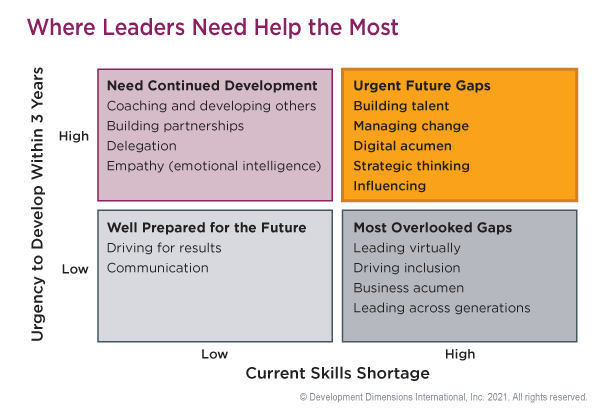Is your organization focusing on developing the skills leaders need to be successful now and in the future? This is a question that more than 2,100 HR professionals and 15,000 leaders answered as part of their response to DDI’s Global Leadership Forecast 2021. And unfortunately, current results show that leaders around the world, across all levels of leadership, aren’t being adequately prepared for the future. This is certainly the strongest signal we’ve found in our research of a looming leadership skills gap.
But what’s causing this leadership skills gap? There’s a significant mismatch between what skills are currently being emphasized in development programs and what skills leaders need. Leaders aren’t prepared for what their companies will need to be successful in the future. And HR isn’t training them for it.
Facing the business challenges ahead, along with a pandemic recovery, won’t be easy. Leaders are going to need to draw on new and strategic capabilities. The results of our analysis of where leaders need help the most is shown in the grid below.

The Leadership Gap of the Future
Topping the list of most critical skills for the future according to both HR and leaders are building talent, managing change, and influencing.
Additionally, according to leaders, digital acumen and strategic thinking are two areas they need to develop as they look to expand new business opportunities for their organizations.
The problem? These five areas highlighted in the yellow quadrant represent the biggest future skills gap. According to the latest findings from Global Leadership Forecast 2021, fewer than half of all leaders feel they are effective in any of these skills. Even worse, they aren’t being developed where they need it most. Only 28% of leaders indicate they are currently receiving development in any of these critical areas for the future.
Most of these skills are also among those leaders need to fight burnout on their teams. While certainly a problem today, the issue of workplace burnout will continue to affect companies in the future. In fact, it’ll likely only get worse if leaders don’t get development in the skills listed in the urgent future gaps area of the chart.
In addition, senior HR leaders indicate that current leadership development programs are focused most heavily on driving for results and communication skills. Although communication skills are foundational, most leaders are already skilled communicators and there are many more urgent skills needed for the future.
Further, most leaders have been promoted for their execution skills and their ability to achieve results. There’s no doubt that these are leadership skills that should be reinforced. However, these skills are currently being overemphasized in most development programs.
The Forgotten Leadership Skills
Among the most overlooked gaps are four skills that leaders will need to help their companies retain talent and navigate the complex challenges ahead. Shown in the lower right grid, this includes skills critical to leading virtual/remote teams and driving inclusion. This also includes business acumen and leading multiple generations in the workforce.
Why are these skills critical for the future? Simply, remote work is here to stay, so leaders better feel confident in their virtual leadership skills.
And what happens without a diverse and inclusive working environment? Your current people are more likely to leave, and you could be missing out on a whole host of talent who won’t want to work for you. And this includes being inclusive to all generations in the workforce. It's important to be a place where everyone feels respected and encouraged to grow.
Don't Let Your Guard Down
Along with critical future gaps, our analysis revealed there are several areas that leaders need reinforcement and continued development. These include coaching and delegation, and building partnerships.
But this also includes one critical skill that grew significantly in importance during the pandemic this past year: empathy. Why is empathy so important?
People want to be understood. And to do this, leaders need to be able to put themselves in the shoes of the people on their team. When this happens, a true connection is born. This connection allows for mutual listening and responding with empathy, which allows for mutual understanding and building trust.
Above all, leaders will need to continue to draw upon these skills as they navigate and drive recovery for their organizations.
How to Measure Your Leadership Skills Gap
Is there a mismatch at your organization between what skills leaders are being developed in currently, and those they will need for the future?
Your answer might be “yes.” And while it’s not what you want, your answer shows you understand how effective (or ineffective) your leaders are in their leadership skills. This is powerful because when you have a baseline, you have a path for growth. Or a path to be able to say, “Let’s keep up the good work.”
It’s the “maybe” or “I don’t know” answers that show a need to learn how to measure for a leadership skills gap. But how to do it?
How to Develop the Leadership Competencies You Need
So once you understand where your leaders are doing well and where they need to improve for the future, what’s next?
You need a plan for how to best develop the competencies your leaders need. And this plan should be focused on reinforcing the most critical skills. Here are four tips:
1. Address the most urgent areas first.
Design development programs around the skills your leaders need to succeed. The most critical skills are those that will help them accomplish strategic objectives.
2. Don’t forget the basics.
It’s easy to assume that leaders have mastered foundational skills by the time they are promoted to their first management roles. However, our ongoing research shows these are often hidden weak areas for leaders, too.
Don’t overlook the basic skills that leaders will need. Most leaders still don’t feel effective in some of the core, basic leadership skills like communication and coaching. These are areas they will continue to need to draw on with their teams, peers, and partners across the organization.
3. Make sure leaders are really practicing skills, not just getting theory.
Many programs educate leaders about the professional skills they need. But they miss the crucial step of providing them sufficient opportunity to practice and apply their new skills.
And aside from practicing skills in class with a colleague, there are many other options. Practice chatbots, immersive simulations, and virtual reality are just a few other ways.
4. Make these competencies a part of your culture.
Ideally, this means developing leaders together. But even if leaders are learning on their own through self-directed learning, you need cultural accountability among teams.
A good way to encourage accountability is to have top-level support for your development programs. When senior leaders support the program and talk about why it’s important, and even how they’ve seen the benefits themselves, others in the organizations will listen.
Closing the Leadership Skills Gap for a Competitive Advantage
Tuning leadership programs with a focus on developing the most critical skills leaders need is the most predictable way to help leaders succeed in the future. It will also pay off as a competitive advantage to have leaders who are effective in future-facing skill sets.
For more of the latest research on leadership, download the Global Leadership Forecast 2021.
Stephanie Neal is director of the Center for Analytics and Behavioral Research (CABER). She leads market and trend research focused on leadership and business innovation, and is general manager and lead author of DDI's Global Leadership Forecast.
Topics covered in this blog

